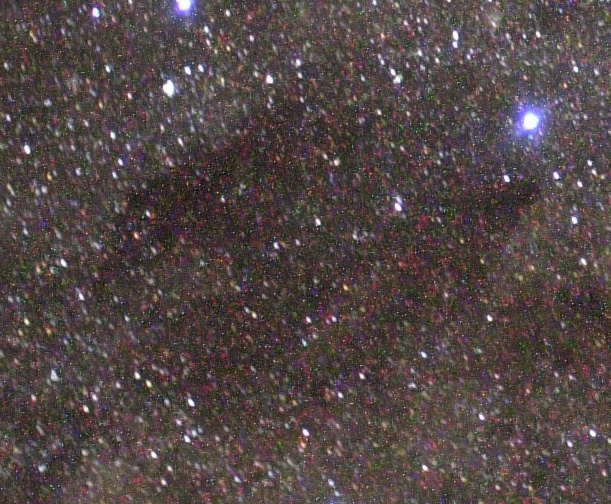Today I will give you a brief overview of a topic that's quite close to me: the effects of dust in interstellar medium. There are some regions in the sky that seem to be almost magically depleted of stars, even in very dense regions. The classical example of this "dark nebulae" is the coalsack in the Crux constellation.
 The coalsack dark nebula is the best known region where interstellar dust is so dense that it blocks all the light (in the visible frequencies) in it's sightline.
The coalsack dark nebula is the best known region where interstellar dust is so dense that it blocks all the light (in the visible frequencies) in it's sightline.This regions are not depleted of stars, but rather the light of the stars in the sightline is absorbed by dust. This is far from obvious, after all there is no a priori reason to discard the idea that this regions simply lack any stars.
The first conclusive evidence of light absorption in the interstellar medium came from the work of Robert Trumpler who measured the angular sizes of globular clusters trying to calculate its distance from Earth. The idea was simple, let's assume that globular clusters are roughly the same size, then the smaller a particular cluster seems to us, the farther it is. When Trumpler carried on this plan he realized that the there was a linear relation between the size and the distance, i.e. the clusters were bigger as the distance to them increased. This was quite unexpected and also seemed to point to the rather disturbing conclusion that Earth is located in a special place where globular clusters are smaller.
Rather than that, Trumpler realized that the distance was systematically overestimated (so the clusters weren't that big, after all). Then he assummed that the reason for this bias was extinction in the interstellar medium, meaning that something (presumably dust) was absorbing light on its way to Earth.
Further evidence for dust comes from light polarization. When light is reflected from a dust grain it is polarized depending on the alignement of the grain, if the grains are aligned with Milky Way's magnetic field, we can then use the dust polarization as a measure of the direction of the magnetic field.
 Measurements of dust polarization, this measurements show that optical polarization is aligned with the magnetic field.
Measurements of dust polarization, this measurements show that optical polarization is aligned with the magnetic field.
What is the composition of this dust? This depends on many factors. Nonetheless the most important one is the distance to a star, particullary to hot, young stars. This stars (known as early spectral type) are so hot that that dust sublimates in its vecinity. The grains composed of carbonites are more resistent (and bigger grains have a better chance of survival), then the silicates enter the stage. In colder enviroments larger molecules appear on the surface of the grains.
How are this grains formed? Why is dust relevant for astrobiology? Which are the effects of dust on ionized regions? Keep tuned for later posts!
The first conclusive evidence of light absorption in the interstellar medium came from the work of Robert Trumpler who measured the angular sizes of globular clusters trying to calculate its distance from Earth. The idea was simple, let's assume that globular clusters are roughly the same size, then the smaller a particular cluster seems to us, the farther it is. When Trumpler carried on this plan he realized that the there was a linear relation between the size and the distance, i.e. the clusters were bigger as the distance to them increased. This was quite unexpected and also seemed to point to the rather disturbing conclusion that Earth is located in a special place where globular clusters are smaller.
Rather than that, Trumpler realized that the distance was systematically overestimated (so the clusters weren't that big, after all). Then he assummed that the reason for this bias was extinction in the interstellar medium, meaning that something (presumably dust) was absorbing light on its way to Earth.
Further evidence for dust comes from light polarization. When light is reflected from a dust grain it is polarized depending on the alignement of the grain, if the grains are aligned with Milky Way's magnetic field, we can then use the dust polarization as a measure of the direction of the magnetic field.
 Measurements of dust polarization, this measurements show that optical polarization is aligned with the magnetic field.
Measurements of dust polarization, this measurements show that optical polarization is aligned with the magnetic field.What is the composition of this dust? This depends on many factors. Nonetheless the most important one is the distance to a star, particullary to hot, young stars. This stars (known as early spectral type) are so hot that that dust sublimates in its vecinity. The grains composed of carbonites are more resistent (and bigger grains have a better chance of survival), then the silicates enter the stage. In colder enviroments larger molecules appear on the surface of the grains.
How are this grains formed? Why is dust relevant for astrobiology? Which are the effects of dust on ionized regions? Keep tuned for later posts!
No comments:
Post a Comment